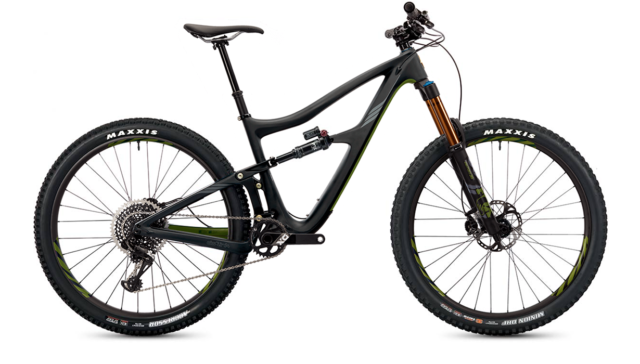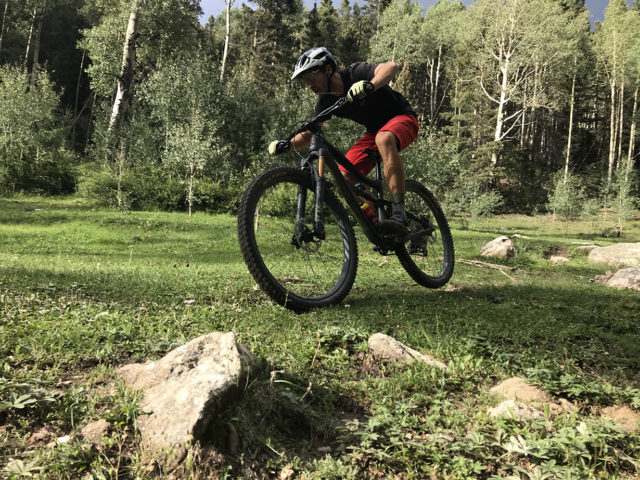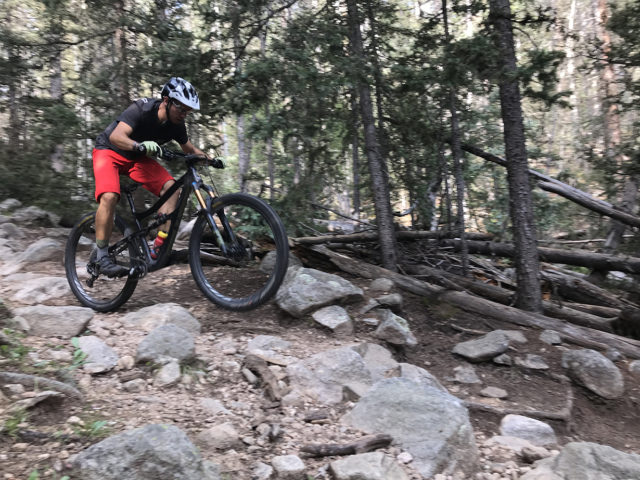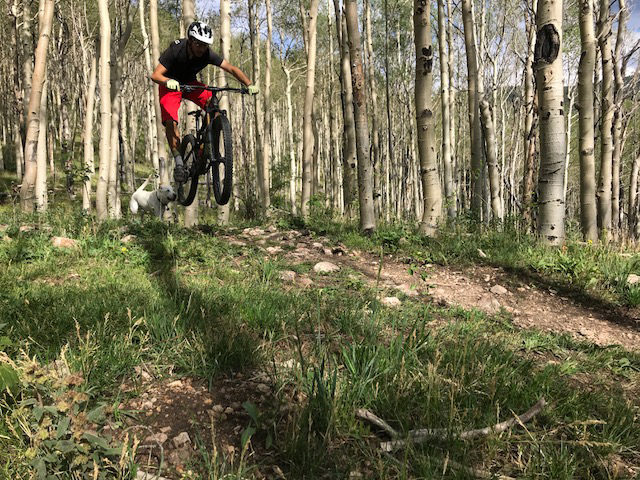2018 Ibis Ripmo
Size Tested: Large
Geometry: (Here)
Build:
- Drivetrain: SRAM XO1 Eagle
- Brakes: Shimano XT
- Fork: Fox 36 Float 29 160 Factory
- Rear Shock: Fox Float Factory
- Wheels: Ibis 942 Carbon Wheels
Wheel size: 29”
Travel: 145 mm Rear / 160 mm Front
Blister’s Measured Weight (No Pedals): 29 lbs (~13.15 kg)
Reviewer: 6’0”, 165 lbs
Test Location: Crested Butte & Poncha Springs, CO; Santa Fe & Angel Fire, NM
Duration of Test: ~3 Months
MSRP:
- X01 Build: $6999
- XX1 Build: $9599

Intro
At this point, most bike companies have some sort of longer-travel 29er, and the popularity of these bikes seems to be growing. So it only seemed like a matter of time before Ibis released their contribution to the longer-travel 29er category: the Ripmo.
So what is the Ripmo? You can read our preview for more info, but it’s essentially a cross between the Ripley LS (Ibis’s 29er Trail bike) and the Mojo HD4 (their long-travel “Enduro” bike).
I’ve spent a good chunk of time on the Ripley LS and was able to quickly demo the Mojo HD 4, and both bikes really impressed me in different ways. The Ripley being an efficient machine in all sorts of terrain and the Mojo being an absolute rock smasher. So the Ripmo would have to be the best of both worlds, right?
The Build
Ibis has a few different builds available for the Ripmo. The lower-end NX build starts at $4,100, and it goes all the way up to the XX1 build at $9,599. In between those sit the GX build ($5,099), X01 build ($6,099), and if you want it spec’d with Shimano, there’s a Shimano XT build for $5,999. If you just want the Ripmo frame, you can get it for $2,999.
The Ripmo build that I was riding was a mix between the X01 and XX1 builds. A Fox 36 Factory Series Fit4 fork with 160 mm of travel and 44 mm of offset took care of business in the front. Fox 36’s get plenty of hype, and I think the hype is mostly justified. The Fit4 fork I tested doesn’t offer high-speed or low-speed compression adjustment, but that’s fine with me as I generally don’t do a ton of tinkering with that.
A Fox DPX2 Performance series rear shock with an Evol air can handled the rear. Apart from the fact that I missed the Kashima coating on the rear, the Performance series shock handled perfectly fine and I’ve never noticed huge differences between Factory vs. Performance rear shocks from Fox. On forks, however, Factory vs. Performance is much more noticeable since with the Performance series you miss out on not just the Kashima coating, but also the higher-end Fit4 and Grip2 dampers.
A Sram X01 Eagle drivetrain took care of shifting duties on the Ripmo. The Eagle’s 32t front ring works great for me thanks to its big range in the back. I’ve been running Eagle drivetrains on most of my bikes recently and have been very impressed. I finally broke my first Sram chain, but that’s what happens when you smash a rock going warp speed down Agate Creek off of the Monarch Crest. Luckily, all Sram Eagle parts are compatible, so a cheap(er) GX chain got me rolling again.
Although I was impressed by the Sram Guide RSC brakes on the Ripley LS, I was happy to have Shimano XT brakes on the Ripmo. Maybe I’m a bit biased towards XT brakes, but they’ve always been reliable for me. 180 mm rotors front and rear, and metallic fin pads meant powerful yet smooth braking for all the steep trails that I seek out. The Ripmo also has space for up to a 203 mm rotor in the rear if extra power is what you are seeking.

The Ripmo I reviewed featured Ibis’s 942 Carbon wheels (35 mm internal width). This was a highlight of the build for sure. After trying these wheels years ago, they still remain some of my favorites. They’re light, stiff, strong, and can run low pressure (Mega grip!). I got away with running some low pressures (20 psi in both front and rear, which is low for me) on some really rocky trails and never had to even true the 942 Carbon wheels.
The Ripmo’s cockpit was another highlight for me. The 31.8 mm Ibis carbon bars that come full-width at 800 mm offered great leverage in the corners, and I found them to be very comfortable. Keeping the bars in place was a 40 mm Thompson X4 stem — another component that was light, stiff, and strong. I’d prefer a stem that could be adjusted with a 4 or 5 mm wrench (the Thompson uses a 3 mm), but that’s just a small nitpicky preference sort of thing, nothing that affected performance.
Cane Creek had headset duties and kept everything smooth. The bike came with Lizard Skin Charger Evo grips, which I wasn’t a huge fan of and swapped out. I didn’t like the texture of them for long descents and opted for some Ergon GE1 grips.
The Ripmo came stocked with a WTB Silverado saddle, but since I spend a lot of very long days in the saddle, I went with something I knew would work well for me (a Specialized Henge Expert). But the Silverado is a pretty popular saddle, so I think most people that don’t have strong opinions about their saddle will probably get along with it just fine.
Another highlight for me was the Ripmo’s 175 mm KS Lev Integra dropper post. This was a game changer. While the KS Lev doesn’t have my favorite lever, it worked well and was reliable enough. But what I was most psyched on was the 175 mm length and the fact that I can run massive dropper posts in the Ripmo (I’ll expand on this more later).
Lastly, I was very happy with the tire choice on the Ripmo I tested. I am quite picky about tires, and this build was stocked with some of my favorites: Maxxis Minion DHF 2.5 in the front and a Maxxis Aggressor 2.5 in the rear. This is one of my favorite tire combos and it once again proved itself on the Ripmo. They reliably pedaled up many roads, smashed down many descents, and after 3 months of extremely hard riding, they still had some life left over.
Overall, this was an extremely well thought out build with parts that are light, stiff, durable, and reliable. Had I been building the bike from scratch, there’s nothing I would change apart from small parts such as the grips and saddle. The meat of the build was top notch.
Frame and Design
Any Ripmo build you end up with will come in carbon. This frame is light and stiff, and weighs around ~2.72 kg (6 lbs) with a rear shock. For a bike this capable on the downhill, that’s quite impressive. As with all Ibis bikes, the Ripmo is designed around the DW (Dave Weagle) linkage. While the Ripmo is a mix between the Ripley LS and the Mojo HD4, the Ripmo’s linkage looks like a carbon copy of the Mojo HD 4’s linkage.
The DW link on the Ripley LS uses an eccentric pivot, whereas the Mojo HD4 uses two short links with two different attachment points on the front triangle. While the concept remains the same for both, the Ripmo uses the latter of those two DW link designs. The goal is to create a platform that optimizes the balance between increasing small-bump compliance and decreasing energy lost through pedaling.
More often than not, I’ve found that the DW link feels a bit more geared toward efficiency, but some longer-travel DW link bikes show that the design can work well where descending is the top priority. The Ripmo was made to do it all, and I think the DW link is part of what helps the bike remain efficient for how big it is and how much travel it has.
The Ripmo’s frame has a bunch of small, but significant features. The internal routing is super clean and relatively simple. Changing cables was a breeze. Changing housing was also easy as Ibis cleverly ran carbon fiber tubes through the frame to act as guides to easily slide new housing through the frame and out of the holes. I have never liked internal routing until now. Thanks Ibis!
The Ripmo has space for a large water bottle in the front triangle, which is noteworthy these days. There’s also room to strap a tube / Co2 / tire levers without interfering with the shock or water bottle.
As far as chain guides go, I was not running one. I’ve had good luck with Sram 1x chainrings without chainguides, but I did drop a couple chains on the Ripmo. The Ripmo is ISCG 05 compatible and there’s an optional adapter if you want to play it safe. Had I been racing Enduro on the Ripmo, I would have added the adapter for a bit of extra security.
The Ripmo’s tire clearance allows for up to 2.6” tires, which gives you plenty of options. A small plastic rock guard is bolted onto the frame near the bottom bracket, and it seems more robust than the rubbery stickers some companies use. And speaking of bottom brackets, the Ripmo is equipped with a threaded bottom bracket for easy maintenance and less creakiness, which is always a plus in my book. No real complaints on the frame. It’s got valuable features, it’s easy to maintain, and it didn’t cause any issues over the 3-month review period.
Fit and Geometry
The Ripmo comes in Small, Medium, Large, and Extra-Large. At 6’0”, I went with the size Large Ripmo (based on Ibis’s size chart).
The Ripmo feels like a big bike compared to other Ibis models (which had generally felt pretty “normal” compared to other bike companies). I would normally ride an XL for most other brands, but the size Large Ripmo definitely fit me well. The Large Ripmo felt roughly comparable to the XL Ripley LS.
The reach for the Large Ripmo sits at 471 mm and its horizontal toptube is 632 mm. Compared to bikes from a few years ago, that would have been pretty long for a Large, but it’s fairly standard these days. The Ripmo’s geometry is comparable to other similar-ish bikes such as the Pivot Firebird 29 or Trek Slash 29, so by modern standards, the Ripmo’s geometry can probably be called average.
The Ripmo’s sizing numbers are relatively comparable to most modern bikes, but I do think you should definitely take a look at the numbers before deciding on which size you’d want. And if you want a little guidance on reading geometry charts, check out our Bike Fit & Geometry Articles.
 I was happy on a Large, despite usually riding XL’s. The jump from Medium to Large is also a significant step up, which is worth noting if you’re deciding between the two sizes. Ibis also puts the size range for a Large as 5’9” to 6’2”, which would put people on the shorter end of that spectrum onto a big bike, especially considering the notable jump in numbers from the Medium to the Large.
I was happy on a Large, despite usually riding XL’s. The jump from Medium to Large is also a significant step up, which is worth noting if you’re deciding between the two sizes. Ibis also puts the size range for a Large as 5’9” to 6’2”, which would put people on the shorter end of that spectrum onto a big bike, especially considering the notable jump in numbers from the Medium to the Large.
At 435 mm on all sizes, the Ripmo has fairly short chainstays which allow such a big 29er to remain rather playful. This chainstay length seems relatively normal for a modern, long-travel 29er: long enough to be stable, but short enough to make the bike maneuverable.
One noteworthy number is the Ripmo’s seat tube — it’s cut quite short at 418 mm on the Large, which meant I was able to run a long dropper post. This is one of the only bikes I’ve ever used where my seat post, when dropped, wasn’t still relatively high — the Ripmo’s post was completely out of the way for descending.
The Ripmo’s head tube angle sits at 65.9°, which is kinda right in the middle of the Ripley LS (67.5°) and the Mojo HD 4 (64.9°). This allows the Ripmo to be slack enough and long enough to plow through rocks at speed but not so slack that you’re compromising the stability of the front end on climbs. With many of the longer-travel 29ers trending towards the slack end of the spectrum, the Ripmo’s head angle is arguably on the steep side, at least compared to the newest bikes in this category.
In terms of keeping the front end planted on climbs, the Ripmo’s 76° seat tube angle helped keep me a bit more forward. Overall, the Ripmo’s geometry isn’t incredibly aggressive. Instead, it’s quite versatile due to the slack-ish head tube angle and the relatively steep seat tube angle. This makes for quality climbing and descending in all sorts of terrain, which seems to have been Ibis’s mission with this bike.
The Ride
The Ripmo definitely took some getting used to for me, and it took a while to figure out the right suspension settings in order to keep things plush but still efficient. On the Ripmo I found myself running more sag than I normally do (around 35%). At this setting, the bike remained pretty efficient on climbs, but I was definitely prioritizing the downhill. Bottoming out was never an issue for me, though I wouldn’t win any awards for the biggest send.
The other tweaking I did with the Ripmo’s suspension was with its rebound settings. Rebound settings definitely come down to rider preference and are also dictated by terrain, but running fast rebound helped the Ripmo liven up on fast-but-rough sections of trail (the type of terrain where this bike shines).
Once I dialed in the suspension’s balance between pedaling efficiency and descending plushness, this bike was capable of almost anything. I rode everything on this bike, from bikepark to back-to-back days of 10,000ft+ of climbing. It’s Robin Wallner’s bike of choice for top-level Enduro racing, but I even saw this bike piloted by Jefe Branham to a 2nd place finish in the Colorado Trail Race (a 550 mile self-supported, ultra-endurance bike race with 75,000 ft of climbing).

So the Ripmo can handle a wide variety of rides, but where does it truly excel? I’d say the answer would be “going fast,” and that refers to both the up and the down.
I noticed that the Ripmo really came alive the faster it went and the steeper the descents got. The long wheelbase, slack-ish head angle, and 29” wheels plowed through rock gardens as if there was nothing there.
The only area where the Ripmo struggled a bit was in really tight terrain. With its 800 mm bars and big wheels, getting through tight sections added more difficulty compared to a smaller bike. That said, the Ripmo was still manageable and I think Ibis made a great call with the short chainstays as they made tight stuff on the wagon wheels fun. It’s also worth noting that any bike of similar stature would face the same “problem” as the Ripmo.
The Ripmo felt best on long climbs with long descents, rather than on rolling terrain. While it didn’t feel sluggish on rolling terrain, it just didn’t feel quite as poppy and light as a bike like the Ripley LS. Without a more sustained and steep descent, the primary benefits of the Ripmo were somewhat lost. This bike craved the biggest, longest downhills I could find and itts 160 mm / 145 mm travel combo felt perfect for those kinds of descents. While its geometry isn’t crazy slack, it’s still slack enough where I could sit back and let the bike eat up the trail in front of me.
When turning back up the hill for the climb, I could really feel the Ripmo’s steep seat tube angle — even on very steep climbs the bike remained planted on the ground. The climb switch on the shock paired with the DW linkage allowed road climbs to remain comfortable when fully locked-out or in Trail mode. With absolutely zero pedal bob when fully locked out and coming it at a reasonable weight, charging up the road to my favorite descent wasn’t a problem but more of a welcome challenge. This bike’s geometry (slack, but not excessively so) and the DW link design allows for a rider to even get out of the saddle and attack climbs with confidence. Clearance for big tires and a wide wheelset (I was running 2.5’s) gives you mega traction on steep, technical uphills.
Comparisons
Being that the Ripmo is a cross between the Ripley LS and the Mojo HD4, it makes sense to compare it to each bike. I have spent a lot of time on the Ripley LS, a bit of time on the Mojo HD4 (although reviewer Noah Bodman got a good chunk of time on it), and 3 months on the Ripmo. Overall, I think the Ripmo is more similar to the Mojo HD4 in terms of what it wants to do, and it seems like a really nice blend between the two bikes.
Noah called the Mojo HD4 “the most DH-oriented bike that I’d still be willing to pedal uphill for a really long time.” I would put the Ripmo in a similar boat. The Ripmo wants you to pedal uphill in order to go as fast as possible down, which is similar to what Noah found with the Mojo HD4.
But what makes the Ripmo unique is that it’s a great bike on the downhill, but then has features from the Ripley LS that make it really versatile, and probably more versatile than the Mojo HD4 in terms of both climbing and descending. This seems to be primarily due to the Ripmo’s shorter travel and steeper angles, two features that stem from the Ripley LS.

On the Mojo HD4 I found that, while it can smash through rock gardens extremely well, it’s not quite as efficient on the uphill compared to the Ripmo and Ripley LS. Meanwhile, the Ripley LS felt almost too efficient and not quite supple enough over small bumps.
I think the Ripmo offers an excellent balance between each bike’s respective designs and the result is a bike that is capable of doing basically everything you’d want it to do. The Ripmo has most of the rock-smashing capabilities of the Mojo HD4 but keeps much of the efficiency of the Ripley LS. Ibis said the Ripmo was essentially a mix between the Ripley LS and Mojo HD4, and I think Ibis did an excellent job of combining the best characteristics of both.
Bottom Line
Finding one bike to do it all is a daunting task. Most companies make a bike that’s supposed to do it all, but with these sorts of bikes there’s often something lacking.
But after my time on it, the Ripmo is probably the best do-it-all bike I’ve used for my style of riding (going fast on the up and the down). While it’s built to be a monster on descents, I think the Ripmo is definitely on another level (compared to other longer-travel bikes) when you want to make a U-turn and climb back out. The Ripmo sacrifices a bit of stability by foregoing the ultra-slack head angle of some other long-travel 29ers, but in terms of the bike’s well-rounded prowess, I think the benefits of its uphill efficiency outweigh any slight decreases in downhill performance.
I wouldn’t by any means say the Ripmo is a bike you should choose to be “comfortable” on. It wants to shred and it wants to shred hard. The faster you go the better this bike feels. If you just want an easy bike that you can chill out on, there are better options. But if you’re looking for a bike to push your limits on, conquer the biggest peaks by up pedaling them from your doorstep, and want to rip down with very little sacrifice, the Ripmo is a wonderful bike could be the bike for you.

Thanks for the review! Any thought about getting on the Transitiom Sentinel for a long travel 29Er shootout?
That would be a fun one! I would like to hop on that bike and see what it’s like!
Hi guys,
Nice review, but wanted to comment on one thing: “On forks, however, Factory vs. Performance is much more noticeable since with the Performance series you miss out on not just the Kashima coating, but also the higher-end Fit4 and Grip2 dampers.” I don’t think this is correct. I have a Fox 36 Performance with the Grip2 damper. Not a big deal, but just thought I’d chime in :)
Great review thanks, I am looking at purchasing, really stuck on sizing, cant throw my leg over one, nearest is 1600 km away!!! I am 180 cm tall and sit almost bang in the middle of the size large they say for this bike. However I currently ride a santa cruz tallboy LTC. I have it overforked to 150 and -1 deg headset angle. the reach is relatively small on the old style at around 385 and i have 800 bars on it with no sweep. I love that fit and going to reach on Large of 471 sounds very big!!! perhaps the medium of 447 would be better??? but then other reviewers say because of the steep seat angle the reach numbers are not very true. I also ride a 2014 size med glory and is a good fit. although pretty small. any help on sizing appreciated, cheers.
My two cents on the sizing with your height would be to go with a medium. I am 6’0″ and almost always on an XL, and the Large Ripmo fit me perfectly. The reach definitely doesn’t feel super super long because of that steeper seat tube angle. Overall though the bike felt a bit bigger than average. It may come down to if you want a bigger fit or a bit more nimble of a bike with a smaller fit. Good luck with your choice!
Nathan
Many thanks for your reply. I do like a more nimble 29er I guess. I have ordered the Ripmo in med gx spec with bar and brake upgrades. Black version for me. We live in Townsville Australia. Rockwheelers Mountain Bike club. As suggested in our club title, massive amount of rocks here, so the wagon wheels really like it. thanks again.
Great review of the Ripmo. I’m at a cross between the Santa Cruz Hightower LT and the IBIS Ripmo. I live in the Southeast U.S. on a mountain with pretty good mountain bike trails. Lots of great intermediate and advanced trails. I like climbing and then ripping downhill. I do a lot of climbing on technical trails. Lots of switch backs too. How would you compare the Ripmo to the Hightower? My current bike is a 27.5 trail bike with 130mm travel. It’s a great trail bike, but I get a lot of pedal strikes on the technical climbs. My bike is fun on the downhill… but has limits. Once you hit a certain speed it tends to loose ground traction. Not cool when a high velocity tree or cliff edge is coming at you. Gotta love those RSC brakes.
Thoughts?
Hey there! Sorry for the late reply. Maybe you’ve already made a decision but I will respond anyways. I haven’t had a chance to give the Hightower LT a chance yet. However, if you say you like climbing and ripping downhill, I can attest that the Ripmo is top notch in that category. Where I was riding a lot on the Ripmo there were lots of techy climbs and switchbacks and the Ripmo rips that up. I’d give the DW link a lot of credit for this because it stays efficient even when fully opened up for those technical climbs. So based off of your riding style explanation I would say the Ripmo is definitely up your alley. An all around ripper of a bike!
Nathan
I’m also stuck on sizing. Having a hard time believing the Ibis size chart, that I would be on a large at 5′ 9.5″ with 31″ inseam. I’ve always ridden a medium, last bike was a medium Intense Tracer, ETT of 597 which is more in line with a medium Ripmo, ETT 603. My lbs is recommending a Large with the saddle moved forward to help with climbing but that seems like a huge bike. I need to try to demo, but appreciate any recs.
You sound like a medium to me! I was rocking the size large at 6’0” and super long legs. Most of my bikes are XL but the large Ripmo fit me well. So at 5’9” I’d say medium but it also comes down to some preference as well.
Really like your Ripmo review. Thanks. One question. You said that there are better options for someone who want to chill out. What are those options. Thanks.
Check out the Ibis Ripley if you want a little less bike!
Hey there! If you’re looking for a shorter travel, less burly bike, check out the new Ripley! Still plenty capable but not as much bike as the Ripmo.